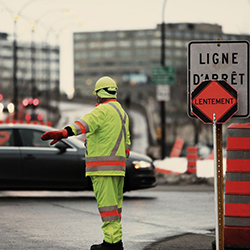Importance of Speed Reducing Measures
Speed reducing measures play a crucial role in ensuring
pedestrian safety. These measures are designed to slow down vehicle speeds, creating a safer environment for pedestrians. By implementing speed reducing measures, such as
speed bumps,
traffic calming zones, and
lower speed limits, the risk of accidents and injuries can be significantly reduced. These measures also encourage drivers to be more cautious and attentive, leading to a positive
behavioral change. It is essential for communities to prioritize the implementation of speed reducing measures to protect pedestrians and create safer streets.
Types of Speed Reducing Measures
There are various types of
speed reducing measures that can be implemented to enhance pedestrian safety. These measures include:
- Traffic calming techniques such as speed humps, speed cushions, and chicanes, which are physical structures that force drivers to slow down.
- Reduced speed limits in high pedestrian areas, which can be enforced through signage and speed cameras.
- Pedestrian-friendly infrastructure, such as raised crosswalks, pedestrian islands, and refuge islands, which provide safe spaces for pedestrians to cross the road.
By implementing these measures, communities can effectively reduce vehicle speeds and create safer environments for pedestrians.
Effectiveness of Speed Reducing Measures
Impact on Pedestrian Safety
Speed reducing measures have a significant impact on
pedestrian safety. By slowing down vehicles, these measures create a safer environment for pedestrians to navigate. Studies have shown that implementing speed reducing measures can lead to a substantial reduction in pedestrian accidents. Additionally, these measures encourage
behavioral changes in drivers, making them more aware of pedestrians and their surroundings. Overall, the implementation of speed reducing measures plays a crucial role in improving pedestrian safety and reducing the risk of accidents.
Reduction in Accidents
Speed reducing measures have been proven to be highly effective in
reducing the number of accidents involving pedestrians. Studies have shown that implementing measures such as
lowering speed limits, installing
traffic calming devices, and
implementing traffic signal changes can significantly decrease the likelihood of accidents occurring. These measures help to
improve visibility,
increase reaction time, and
reduce the severity of collisions. By reducing the speed at which vehicles travel, the risk of accidents and injuries to pedestrians is greatly reduced, making our streets safer for everyone.
Behavioral Changes in Drivers
Behavioral changes in drivers are a crucial aspect of implementing speed reducing measures.
Education and
awareness campaigns can help drivers understand the importance of driving at a safe speed and the potential consequences of speeding. Additionally,
enforcement of speed limits through
traffic policing and
speed cameras can encourage drivers to comply with speed regulations. Studies have shown that when drivers perceive a higher risk of getting caught for speeding, they are more likely to reduce their speed. By promoting responsible driving behavior, we can create safer streets for pedestrians and reduce the number of accidents caused by speeding.
Implementation of Speed Reducing Measures
Design Considerations
When implementing
speed reducing measures, several design considerations must be taken into account. Firstly, the chosen measures should be
appropriate for the specific road or area, considering factors such as traffic volume, pedestrian activity, and speed limits. Secondly, the
visibility of these measures is crucial to ensure that drivers can easily identify and react to them. This can be achieved through clear signage, road markings, and the use of
high-contrast colors. Additionally, the
placement of speed reducing measures should be strategic, targeting areas where speeding is most prevalent or where pedestrian safety is a concern. By carefully considering these design factors, speed reducing measures can effectively contribute to creating safer streets for pedestrians.
Integration with Existing Infrastructure
When implementing speed reducing measures, it is crucial to consider the integration with
existing infrastructure. This ensures that the measures are seamlessly incorporated into the current road network and do not disrupt the flow of traffic. It is important to assess the compatibility of speed reducing measures with the existing road design, such as the presence of pedestrian crossings, traffic signals, and road signs. Additionally, considering the
cost-effectiveness of integrating these measures can help prioritize implementation in areas where they will have the greatest impact. Engaging with local authorities and transportation agencies can provide valuable insights and support in integrating speed reducing measures into the existing infrastructure.
Conclusion
There have been several successful examples of
speed reducing measures implemented in various cities around the world. One notable example is the installation of
speed humps in residential neighborhoods. These raised platforms force drivers to slow down, reducing the risk of accidents and improving pedestrian safety. Another effective measure is the implementation of
traffic calming zones, which include features such as narrowed lanes, speed limit reductions, and increased signage. These measures have been shown to significantly reduce the number of accidents and promote safer streets. Additionally, the use of
pedestrian islands and
crosswalk enhancements have proven to be effective in improving pedestrian safety by providing designated areas for pedestrians to cross safely. These successful examples demonstrate the importance and effectiveness of implementing speed reducing measures to create safer streets for pedestrians.
As technology continues to advance, there are several
future trends in speed reduction that hold promise for improving pedestrian safety. One of these trends is the development of
smart traffic signals that can detect the presence of pedestrians and adjust signal timing accordingly. This can help reduce the risk of accidents by giving pedestrians more time to cross the road safely. Another trend is the use of
intelligent speed adaptation systems, which can automatically adjust the speed of vehicles based on the surrounding environment and road conditions. These systems can help prevent speeding and improve overall road safety. Additionally, the implementation of
traffic calming measures, such as raised crosswalks and speed humps, is expected to become more widespread in the future. These measures can effectively slow down vehicles and create a safer environment for pedestrians. Overall, these future trends in speed reduction have the potential to significantly enhance pedestrian safety and reduce the number of accidents on our streets.

